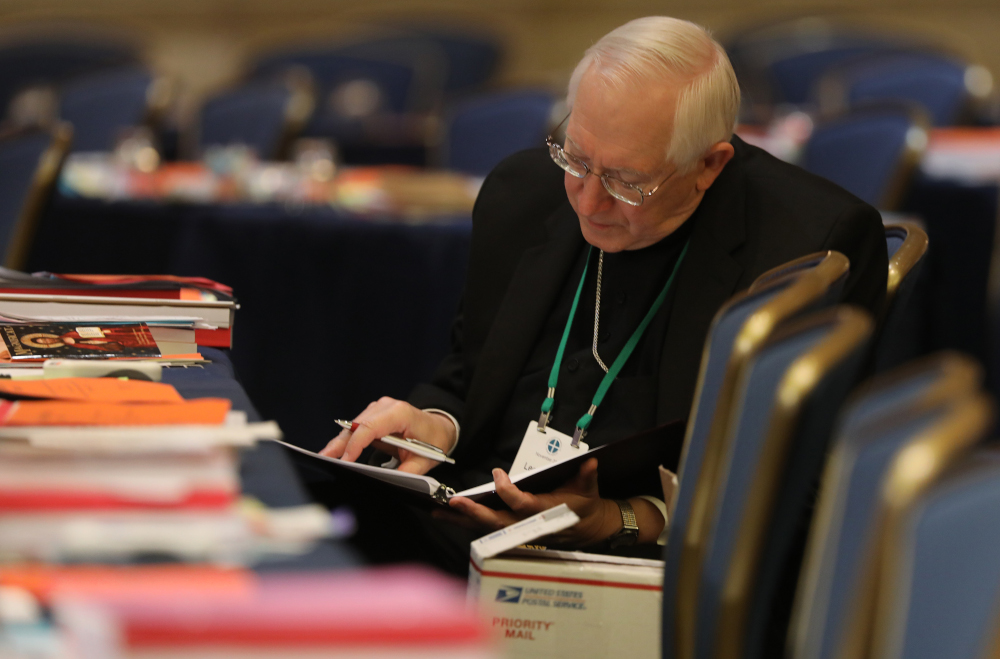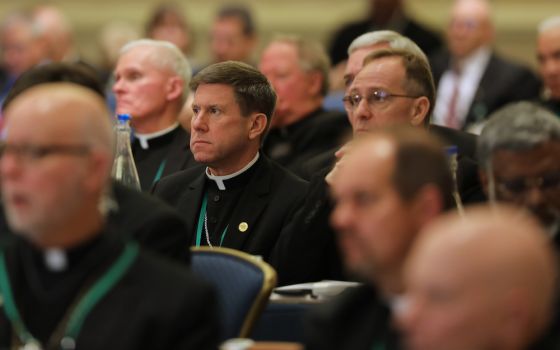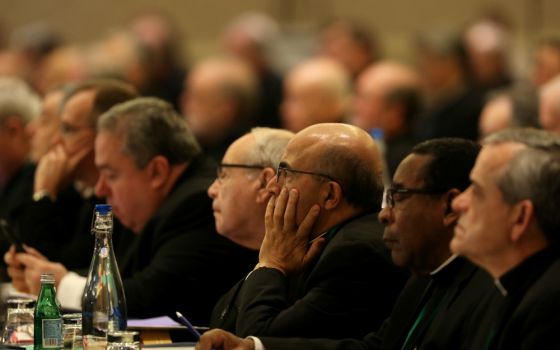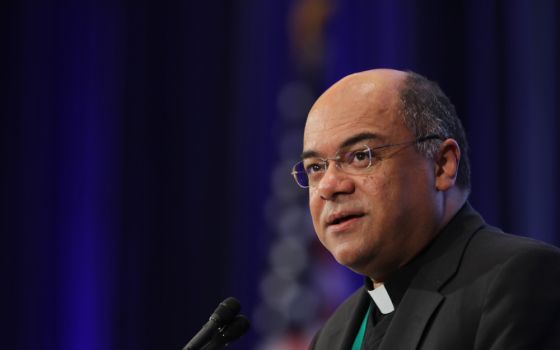
Archbishop Leonard Blair of Hartford, Conn., looks over material before the start of the second day of the fall general assembly of the U.S. Conference of Catholic Bishops in Baltimore Nov. 12, 2019. (CNS/Bob Roller)
The U.S. bishops voted to approve close to 300 new hymn texts for the Liturgy of the Hours. The Nov. 12 vote was 205-5 with two abstentions.
The proposal needed two-thirds of the Latin-rite bishops to vote yes, or 164 votes. They must now receive confirmation from the Vatican Congregation for Divine Worship and the Sacraments.
This effort is part of a "scope of work" authorized by the bishops in 2012, according to Archbishop Leonard Blair of Hartford, Connecticut, who addressed the bishops on the proposal Nov. 12, the second day of the three-day fall general meeting in Baltimore.
He was filling in for Archbishop Wilton Gregory of Washington, chairman of the bishops' Committee on Divine Worship, who was in Rome. As the committee's chairman-elect, Blair succeeds Gregory as chairman at the end of the meeting.
The International Commission on English in the Liturgy – a consortium of liturgists from the world's English-speaking episcopal conferences – "and its team of translators and musicians has worked for several years to prepare this large collection of hymns," Gregory said in a message to his fellow bishops that accompanied the 294 hymn texts.
"ICEL has aimed to capture the content of the texts with fidelity, while maintaining as much as possible their original meter," he added. "While the hymns do not rhyme, they are designed to be suited for singing with both traditional Gregorian melodies and also with more familiar hymn tunes."
Blair noted, "The Latin originals do not rhyme, either."
The commission, in an introduction to the hymn texts, said it avoided rhymes because "the meaning of the text can be compromised by extraneous words introduced for the sake of rhyme" and "the text is often subjected to awkward inversions of syntax in order to line up rhyming words at the end of the lines in a stanza."
"Although rhyme has traditionally been a prominent feature of English hymnody, it is not a prominent feature of Latin hymnody. Even where Latin hymns do rhyme, the likeness of word endings does not predominates when a Latin hymn is recited or sung," it added. "By preserving the original meters of the Latin hymns, without the extraneous addition of rhyme, ICEL has preserved the poetic nature of the hymns, without distorting the texts or losing theological content."
Advertisement
The commission said one of the principles it employed in the translations was "to produce English texts that reflect the sobriety and theological depth of the rich and living tradition of hymnody that is the treasure of the Western church."
The commission said it tested the text of the English translations "for simplicity and clarity of diction," using "world class church musicians familiar with both Latin and English hymnody." A demonstration is expected to be part of the presentation when the agenda item is introduced during the bishops' Nov. 11-13 fall general meeting in Baltimore.
"Hymn writers from every era have given us the contents of this collection and they show us the beauty and holiness of the church at prayer, through the hours of the day and throughout the seasons of the liturgical year," the commission said.
"One of the great characteristics of the Latin is a sobriety, simplicity and elegance that says all that is needed without excess. The result of this is an intensity and depth of theological expression."
A chorale made up of students from The Catholic University of America in Washington and members of the Fellowship of Catholic University Students, with piano accompaniment, sang for the bishops two hymn texts using both Gregorian chant and hymn tunes of considerably more recent vintage, one of them being "Tallis' Canon," a hymn tune from 16th-century English composer and organist Thomas Tallis.
Bishop Christopher Coyne of Burlington, Vermont, a member of the Committee on Divine Worship, raised the possibility of an app being developed to supply Gregorian and more modern melodies when someone encounters a hymn text in the breviary.
"We anticipate these being published as a hymnal," Blair said, "but not (including music) in the actual breviary itself, for reasons of length and such."







